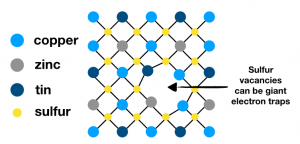by Samantha Hood, via Energy Post

Around 95% of the world’s solar modules are made with silicon. It’s stable against temperature and humidity fluctuations and we’ll never run out of it. But it’s quite inefficient at absorbing sunlight, and very brittle. So the silicon layers in PV have to be quite thick to capture sunlight and resist cracking, leading to heavy and bulky solar panels. The remaining 5% of solar modules are “thin film”, opening the way for game-changing lightweight and flexible applications. But they’re made from rare elements, slow to process, and can be highly toxic. Samantha Hood at Imperial College runs through the “thin film” challenges and describes the research looking into the creation of stable, light-to-electricity efficient, non-toxic modules made from abundant materials that will make terawatt scale solar PV a commonplace so that we can increase today’s 600GW of solar photovoltaic capacity a hundredfold by 2050.
Solar power has tremendous capacity to provide society with clean energy by displacing coal and oil used for electricity generation and transport. One key technology is photovoltaics (PV), which is used in the solar panels you see on the roofs of building and in large farms. Currently there is about 600 GW of solar photovoltaic capacity installed worldwide, with estimates of up to 63 TW (100 times present day) being installed by 2050 thanks to the continuing reduction in price of solar modules, rapid technological advancement and progressive renewable energy policy in the face of climate change.
Currently, electricity and transport emit approximately 25 billion tonnes of CO2 per year. For each terawatt (TW) of PV installed, it is estimated that 1.5 billion tonnes of CO2 can be displaced from electricity and transport industries annually. If we could install a TW of PV each year over the next 16 years, this would eliminate CO2 emissions from these sectors.